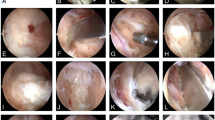Abstract
Purpose
Compared to titanium cage, polyetheretherketone (PEEK) cage with pedicle screw fixation has been increasingly used in transforaminal lumbar interbody fusion (TLIF). However, there is insufficient evidence supporting the superiority of PEEK cages over titanium cages as optimal TLIF spacers. The aim of this study was to compare the clinical and radiographic outcomes of patients at a 2-year follow-up after undergoing instrumented TLIF in which either a PEEK cage or a titanium cage was implanted.
Materials and methods
We retrospectively analyzed prospectively collected 48 patients who underwent single-level TLIF in which the first 23 patients received a titanium cage and the 25 patients received a PEEK cage. Patient demographics, clinical outcomes, and radiographic imaging were studied.
Results
Improvement of clinical outcomes was comparable between the two groups. Based on the criteria using computed tomography, 96 % in the Titanium group and 64 % in the PEEK group showed fusion at 12 months. At 24 months, fusion rate in the Titanium group was increased to 100 %, while PEEK group showed 76 % of fusion rate. In the PEEK group, vertebral osteolysis was noted in 60 % of the cases with nonunion. This abnormal finding was not observed in the Titanium group. Vertebral osteolysis was significantly associated with nonunion.
Conclusions
The superiority of PEEK cages over titanium cages for bony fusion was not demonstrated. Additionally, we found unfavorable radiographic findings in the cases with a PEEK cage, which may lead to nonunion. Improvement in biocompatibility of a PEEK cage will be needed to increase the fusion rate.



Similar content being viewed by others
References
Brantigan JW, Steffee AD, Lewis ML, Quinn LM, Persenaire JM (2000) Lumbar interbody fusion using the Brantigan I/F cage for posterior lumbar interbody fusion and the variable pedicle screw placement system. Spine 25:1437–1446
Helgeson MD, Lehman RA, Patzkowski JC, Dmitriev AE, Rosner MK, Mack AW (2011) Adjacent vertebral body osteolysis with bone morphologic protein use in transforaminal lumbar interbody fusion. Spine J 11:507–510
Sethi A, Craig J, Bartol S, Chen W, Jacobson M, Coe C, Vaidya R (2011) Radiographic and CT evaluation of recombinant human bone morphogenic protein-2 assisted spinal interbody fusion. AJR 197:128–133
Meisel HJ, Schnoring M, Hohaus C, Minkus Y, Beier A, Ganey T, Mansmann U (2008) Posterior lumbar interbody fusion using rhBMP-2. Eur Spine J 17:1735–1744
Putzier M, Strube P, Funk JF, Gross C, Monig HJ, Perka C, Pruss A (2009) Allogenic versus autologous cancellous bone in lumbar segmental spondylodesis: a randomized prospective study. Eur Spine J 18:687–695
Nagahama K, Kanayama M, Togawa D, Hashimoto T, Minami A (2011) Does alendronate disturb the healing process of posterior lumbar interbody fusion? A prospective randomized trial. J Neurosurg Spine 14:500–507
Schimmel JJP, Poeschmann MS, Horsting PP, Schonfeld DHW, van Limbeck J, Pavlov PW (2012) PEEK cages in lumbar fusion: mid-term clinical outcome and radiological fusion. J Spinal Disord Tech. doi:10.1097/BSD.0b013e31826eaf74
Knox JB, Dai JM, Orchowski J (2011) Osteolysis in transforaminal lumbar interbody fusion with bone morphogenetic protein-2. Spine 36:672–676
Vadapalli S, Sairyo K, Goel VK, Robon M, Biyani A, Khandha A, Ebraheim NA (2006) Biomechanical rationale for using polyetheretherketone spacers for lumbar interbody fusion—a finite element study. Spine 31:992–998
Lee JH, Lee JH, Park JW, Lee HS (2011) Fusion rates of a morselized local bone graft in polyetheretherketone cages in posterior lumbar interbody fusion by quantitative analysis using consecutive three-dimensional computed tomography scans. Spine J 11:647–653
Song KJ, Lee KB, Ham DH (2011) Efficacy of posterior lumbar interbody fusion using PEEK cage and pedicle screw stabilization in degenerative lumbar spinal disorders: minimum 3 years follow up results. J Korean Soc Spine Surg 18:230–238
Blumenthal SL, Gill K (1993) Can lumbar spine radiographs accurately determine fusion in postoperative patients? Correlation of routine radiographs with a second surgical look at lumbar fusions. Spine 18:1186–1189
Cook SD, Patron LP, Christakis PM, Bailey KJ, Banta C, Glazer PA (2004) Comparison of methods for determining the presence and extent of anterior lumbar interbody fusion. Spine 29:118–123
Kant AP, Daum WJ, Dean SM, Uchida T (1995) Evaluation of lumbar spine fusion. Plain radiographs versus direct surgical exploration and observation. Spine 20:2313–2327
Diedrich O, Perlick L, Schmitt O, Kraft CN (2001) Radiographic characteristics on conventional radiographs after posterior lumbar interbody fusion: comparative study between radiotranslucent and radiopaque cages. J Spinal Disord 14:522–532
Cutler AR, Siddiqui S, Mohan AL, Hillard VH, Cerabona F, Kaushik D (2006) Comparison of polyetheretherketone cages with femoral cortical bone allograft as a single-piece interbody spacer in transforaminal lumbar interbody fusion. J Neurosurg Spine 5:534–539
Navarrete RO, Gittens RA, Schneider JM, Hyzy SL, Haithcock DA, Ullrich PF, Schwartz Z, Boyan BD (2012) Osteoblasts exhibit a more differentiated phenotype and increased bone morphogenetic protein production on titanium alloy substrates than on poly-ether-ether-ketone. Spine J 12:265–272
Vaidya R, Sethi A, Bartol S, Jacobson M, Coe C, Craig JG (2008) Complications in the use of rhBMP-2 in PEEK cages for interbody fusions. J Spinal Disord Tech 21:557–562
Fujibayashi S, Takemoto M, Izeki M, Takahashi Y, Nakayama T, Neo M (2012) Does the formation of vertebral endplate cysts predict nonunion after lumbar interbody fusion? Spine 37:E1197–E1202. doi:10.1097/BRS.0b013e31825d26d7
Acknowledgments
No funds were received in support of this work.
Author information
Authors and Affiliations
Corresponding author
Rights and permissions
About this article
Cite this article
Nemoto, O., Asazuma, T., Yato, Y. et al. Comparison of fusion rates following transforaminal lumbar interbody fusion using polyetheretherketone cages or titanium cages with transpedicular instrumentation. Eur Spine J 23, 2150–2155 (2014). https://doi.org/10.1007/s00586-014-3466-9
Received:
Revised:
Accepted:
Published:
Issue Date:
DOI: https://doi.org/10.1007/s00586-014-3466-9




